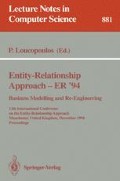Abstract
Research on schema integration leads to the identification of many different conflict types. Some of them received much attention and many papers proposed solutions for their resolution. However, literature usually focuses on traditional problems, whilst new kinds of schema discrepancies, due to the object orientation or the generalization concept, are not really treated. Moreover, most of the proposed methodologies and strategies only allow binary comparisons between items to be integrated.
This paper discusses n-ary (also called one-many) conflicts, and particularly the three fragmentation conflict types. These conflict types need specific operators for schema comparison. We propose a simple unified language for easy specification of these conflicts, and give many different techniques to solve them. We emphasize the benefit of separating the declaration of the correspondences from the choice of resolution technique.
Our discourse is illustrated with the entity-relationship model, but our solutions can be applied in any data model. We propose several conflict resolution techniques that can be applied on a concept which has the generalization (the entity type) and different techniques that must be applied on a concept which has not (the relationship type).
Preview
Unable to display preview. Download preview PDF.
References
Batini C., Lenzerini M., Navathe S., “A Comparative Analysis of Methodologies for Database Schema Integration”, ACM Computing Surveys, Vol. 15, n °4, Decembre 1986, pp 323–364
Bouzeghoub M., Comyn-Wattiau I., “View Integration by Semantic Unification and Transformation of Data Structures”, 9th International Conference on Entity-Relationship Approach, Lausanne, October 8–10, 1990
Carré B., Geib J.-M., “The Point of View notion for Multiple Inheritance”, Proceedings of the ECOOP/OOPSLA International Conference, October 21–25, 1990, pp 312–321
Dayal U., Hwang H., “View definition and Generalization for Database Integration in a Multidatabase System”, IEEE Trans, on Software Eng. Vol SE 10, No 6, Nov. 1984, pp 628–644
DeMichiel L., “Resolving Database Incompatibility: An Approach to Performing Relational Operations over Mismatched Domains”, IEEE Transactions on Knowledge and Data Engineering, Vol. 1, No.4, Dec. 1989
Dupont Y., Andersson M., “Schema Engineering in a Federated Database System”, Proceedings of the workshop on Interoperability of Database Systems and Database Applications, G. Weikum Editor, Fribourg (Switzerland), Octobre 13–14, 1993.
Elmasri R., Hevner A., Weeldreyer J., “The Category Concept; An Extension to the Entity-Relationship Model”, Data and Knowledge Engineering, Vol. 1, No.1, Juin 1985, pp75–116
ElMasri R., Larson J., Navathe S., “Schema Integration Algorithms for Federated Databases and Logical Database Design. Tec. Rep. CSC-86-9, Honeywell Corporate Systems Development Division, Minneapolis, MN.
Goldstein I, Bobrow D., “Descriptions for a programming environment”, Proc. of the first Annual conference on artificial intelligence, AAAI-1, Stanford Cal., August 18–21, 1980.
Johannesson P., “Schema Transformations as an Aid in View Integration”, 5th Conf. on Advanced Information Systems Engineering, CAiSE'93, Paris, France, Juin 1993
Kim W., Choi L, Gala S., Scheevel M., “On Resolving Schematic Heterogeneity in Multidatabase Systems”, in Distributed and Parallel Databases Journal, Kluwer Academic Publishers, Vol. 1 no 3, July 1993
Krishmamurthy R., Litwin W., Kent W., “Language Features for Interoperability of Databases with Schematic Discrepancies”, Proc. of the First International Workshop on Interoperability in Multidatabase Systems, IMS'91, Kyoto (Japan), IEEE-CS Press, 1991
Larson J. A., Navathe S. B., Elmasri R., “A Theory of Attribute Equivalence in Databases with Application to Schema Integration”, IEEE TOSE, Vol. SE-15, no 4, April 1989
Mannino M.V., W, Effelsberg, “Matching Techniques in Global Schema Design”, IEEE International Conference on Data Engineering, Los Angeles, April 24–27, 1984, 418–425
Motro A., “Superviews: Virtual Integration of Multiple Databases”, IEEE Transaction on Software Engineering, Vol. SE-13, no 7, July 1987, 785–798
Ouksel A, Naiman C., “Cooperation in Heterogeneous Database systems”, in Proc. of Int. workshop on next generation information technologies and systems, 28–30 Juin 1993, Haifa, Israel, Etzion O & Segev A. editors
Parent C., Spaccapietra S., “ERC+: an object based entity-relationship approach”, in Conceptual Modelling, Databases and CASE: An Integrated View of Information Systems Development, P.Loucopoulos,. R.Zicari Eds., John Wiley, 1992
Perl Y., Geller J., Neuhold E.J., Turau V., “The Dual Model for Object-Oriented Databases”, Research Report CIS-91-30, New Jersey Institute for Technology
Saltor F., Castellenos M. G., Garcìa-Solaco M, “Overcoming Schematic Discrepancies in Interoperable Databases”, in Semantics of Interoperable Database Systems, Proc. of the Fifth Conf. on Database Semantic, IFIP DS-5, Lorne, Victoria Australia, Nov. 16–20 1992
Scholl M.H. and Schek. H.-J., “A relational object model.” In Proc. 3rd Int'l Conf. on Database Theory (ICDT'90), Paris, 1990.
Sheth A. P., Gala, “Attribute Relationships, An Impedient in Automating Schema Integration”, Proc of the Workshop on Heterogeneous Database Systems, Chicago, Dec. 1989
Sheth A.P., Larson J.A., “Federated Database Systems for Managing Distributed, Heterogeneous, and Autonomous Databases”, ACM Computing Survey, Sept. 1990, Vol 22, No 3
Sheth A., Kashyap V., “So Far (Schematically) yet So Near (Semantically)”, in Semantics of Interoperable Database Systems, Proc. of the Fifth Conf. on Database Semantic, IFTP DS-5, Lorne, Victoria Australia, Nov. 16–20 1992
Shoval P., Zohn S., “Binary-relationship integration methodology”, Data and Knowledge Engineering, Elsevier Pub., Vol. 6, No 3 May 1991, pp 225–250
Spaccapietra S., Parent C., “Conflicts and Correspondance Assertions in Interoperable Databases”, ACM SIGMOD Record, Vol. 20, No 4, Dec. 1991
Spaccapietra S., Parent C., Dupont Y. “Model Independent Assertions for Integration of Heterogeneous Schemas”, Very Large Data Bases Journal, Vol. 1, no 1, 1992
Stefik M., Bobrow D., “Object-Oriented Programming: Themes and Variations”, The AI magazine, January 1986, pp 40–62
Verheijen G., Van Bekkum J., “NIAM: an information analysis method”, in Information Systems Design Methodologies, Olle, Sol and Verryn-Stuart eds, North-Holland 1982
Author information
Authors and Affiliations
Editor information
Rights and permissions
Copyright information
© 1994 Springer-Verlag Berlin Heidelberg
About this paper
Cite this paper
Dupont, Y. (1994). Resolving fragmentation conflicts in schema integration. In: Loucopoulos, P. (eds) Entity-Relationship Approach — ER '94 Business Modelling and Re-Engineering. ER 1994. Lecture Notes in Computer Science, vol 881. Springer, Berlin, Heidelberg. https://doi.org/10.1007/3-540-58786-1_99
Download citation
DOI: https://doi.org/10.1007/3-540-58786-1_99
Published:
Publisher Name: Springer, Berlin, Heidelberg
Print ISBN: 978-3-540-58786-6
Online ISBN: 978-3-540-49100-2
eBook Packages: Springer Book Archive

